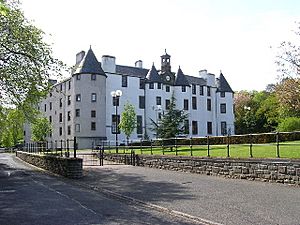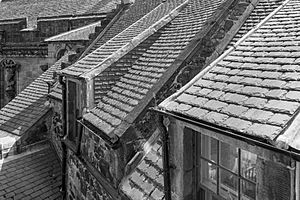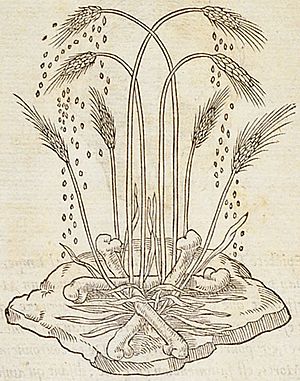Magdalen Livingstone facts for kids
Magdalen Livingstone lived from about 1560 to 1613. She was an important Scottish courtier. She was a favorite lady-in-waiting to Mary, Queen of Scots. Later, she also worked for Prince Henry, the son of King James VI.
Contents
Serving Mary, Queen of Scots
Magdalen was the daughter of Alexander Livingston, 5th Lord Livingston. Her mother was Agnes Douglas. Her older sister, Mary Livingston, was also a lady-in-waiting to the queen. Mary was one of the famous "four Maries."
Magdalen served Mary, Queen of Scots until 1567. She was very popular at the queen's court. Other ladies-in-waiting in 1566 included Lucrece Beaton and Barbara Sandilands.
Her first husband was Arthur Erskine of Blackgrange. He was the son of John Erskine, 5th Lord Erskine. For their wedding in January 1562, the queen gave Magdalen a special skirt. It was made of cloth of gold with matching sleeves. In May 1563, Mary gave her a black taffeta dress. It had wide sleeves bordered with velvet.
When Queen Mary was expecting a baby, Magdalen helped her. Mary made a will, deciding who would get her jewels. If the queen died, Magdalen would receive many valuable items. These included gold clothing points, a set of jewels for her hair, a necklace, and a watch. The watch was set with rubies and two sapphires.
Mary's Time at Jedburgh
Arthur Erskine worked in the royal stables. He helped Queen Mary escape from Holyrood Palace in March 1566. This happened after the murder of David Rizzio. Erskine and Magdalen Livingstone stayed at Dryburgh Abbey for two days. Then they rode to Jedburgh to meet Mary, Queen of Scots.
While in Jedburgh, Queen Mary rode to Hermitage Castle. She went to visit the Earl of Bothwell. After this visit, Mary became very ill. She stayed in Jedburgh to recover. Special fruits like pomegranates and lemons were sent from Edinburgh for her. These were thought to help her feel better.
King James VI at Stirling Castle

In 1567, Queen Mary gave linen to her household for Easter. Magdalen was listed as "Madame Dasquin" among the ladies.
Magdalen Livingstone helped raise King James VI at Stirling Castle. She gave the young king several books. These included a Latin and French dictionary. She also gave him a French manuscript of the Illiad. Other gifts were an illustrated Book of Maccabees and Metamorphoses. She also gave him Devises Heroïques by Claude Paradin. King James gave her an English psalm book in return. An inventory from 1585 mentions "Maidlane Levingstoun's" room at Stirling Castle.
Lady Dudhope
After her first husband, Arthur Erskine, died, Magdalen married again. She married Sir James Scrimgeour of Dudhope Castle in 1577. After this marriage, she became known as "Lady Dudhope." Before they married, Scrimgeour gave her some land. This included the lands and mill of Dudhope. He also promised her other properties nearby.
Their initials were carved in many places at Dudhope Castle. One stone with her initials and the Livingstone family symbol was dated 1600. This marriage made Mary, Queen of Scots, "infinitely" unhappy. She even canceled a gift she had planned for Magdalen.
Serving Anne of Denmark and Prince Henry
In 1589, Magdalen, Lady Dudhope, had an important role. She was chosen to welcome Anne of Denmark to Scotland. Anne was arriving at the shore of Leith. Magdalen was with other important ladies like Annabell Murray, Countess of Mar and Lady Seton.
In 1594, Magdalen was appointed a lady-in-waiting. She served in the household of Prince Henry at Stirling Castle. Her niece, Margaret Livingstone, Countess of Orkney, also served there. Other ladies of honor at Stirling included the Countess of Mar and Lady Clackmannan.
Sir James Scrimgeour, Magdalen's husband, died on July 13, 1612. He passed away at Holyrood Palace.
Death
Magdalen Livingstone died on March 2, 1613.
Her belongings included many beautiful jewels. She had a golden belt and a chain of pearls. She also had a pearl necklace with gold pieces set with rubies and a diamond. One special item was a gold locket. It had a portrait of Anne of Denmark on it. This locket was set with 9 diamonds and 11 rubies. Magdalen left this locket to her nephew, the Earl of Linlithgow. She left other jewels and clothes to Margaret Semple. Margaret was the daughter of Magdalen's sister, Mary Livingston.
King James visited Dudhope Castle on May 21, 1617.



